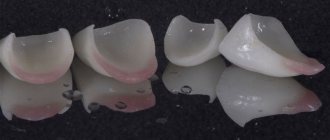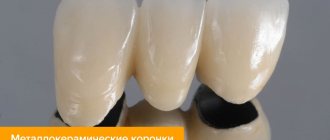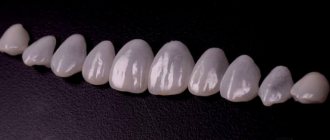A beautiful smile is a person’s calling card. The condition of your teeth affects not only your physical but also your mental health. It is also an indicator of success.
Previously, dentistry used dental crowns to restore even slightly damaged teeth. To do this, they had to sacrifice their natural teeth and subject them to severe grinding. Or remove the coronal part completely.
Now technologies make it possible to eliminate defects on the surface of the tooth, practically without processing it. For this, ultra-thin plates are used that are fixed on the outside of the tooth - veneers. The most popular of them are ceramic veneers, which have a high degree of aesthetics.
What it is?
Despite their ultra-thinness, the strength of the plates is comparable to the hardness of natural tooth enamel. The material allows you to repeat the shape of the tooth with maximum accuracy, hiding visible defects on its surface.
The demand for ceramic veneers is due to their practicality and full compatibility with the human body. The pads are non-toxic, do not cause allergic reactions, and do not require addiction. The translucent material is identical to natural tooth enamel. The shade scale allows you to select the color of the veneers that is similar to the shade of the patient’s teeth.
There are no problems with installing veneers: the plates are attached to the outside of the tooth using a dental compound.
pros
Fixing veneers is the fastest and most painless way to restore the aesthetics of teeth. Yes, the teeth are pre-treated. However, turning is no more than 0.5 mm.
The minimum duration of the procedure is associated not only with the immediate installation of veneers, but also with the number of visits to the dentist. If the patient does not require pre-treatment, the entire process will require no more than 3 visits to the doctor.
Important: you should not trust advertising that promises a Hollywood smile using veneers in one session. The plates are made in a dental laboratory based on previously taken impressions of the patient’s jaw. The work is complex, requiring extreme concentration and high professionalism. Therefore, it is impossible to create ceramic veneers in an hour or even in 2 hours.
Some methods of prosthetics require a long period of getting used to new teeth. Overlays do not fall into this category. After fixing microprostheses, unusual sensations may occur due to the appearance of a foreign structure in the oral cavity. But in just a day or two, the discomfort will disappear. Ceramic veneers do not affect the patient’s usual lifestyle, eating and diction.
Long service life is one of the main advantages of the plates. On average, veneers “live” for at least 15-20 years. When used correctly, of course. In addition, microprostheses can be installed in patients with high sensitivity - rejection and allergic reactions are excluded.
Disadvantages of the design
The main disadvantage of veneers is the price. For this reason, the procedure is not available to everyone. If we are talking about a minor flaw, then you can choose a more budget option - composite veneers. The material is applied directly to the tooth surface. And under the influence of the light flux, it gradually, layer by layer, hardens, forming a plate.
If the problem is related to darkening of the enamel, you can use a professional whitening procedure. The service is less expensive, but no less effective.
Another disadvantage of plates is the grinding of teeth. No matter what thin ceramic veneers are used, it will not be possible to simply remove the structure from the teeth. You will need to install a new onlay or crown.
Nature or whiteness
Everyone knows: if you want to correct the shade, shape and size of your teeth, get veneering, which will help you look ten years younger.
How does this happen? As we age, the skin, body and bone organs of the mouth undergo aging. Teeth wear down and their appearance changes for the worse. They become short in length, which disrupts the paths of the canines and incisors. The facial muscles begin to work incorrectly, reducing chewing efficiency.
To protect the patient from the formation of facial and statistical folds, wrinkles in the nasolabial area, and to ensure a beautiful smile line, specialists add height and volume to the elements of the dentition if they are deficient.
Much attention is paid to nature and whiteness. All of these factors have a positive effect on appearance: the patient looks younger than his age.
Many patients with naturally soft tooth enamel want to whiten them several shades with the help of veneering so that their smile will be snow-white, like a movie star.
Experts do not recommend overdoing it, because excessive whiteness can not decorate, but ruin the overall appearance. Best the enemy of the good.
If you look deeply into this issue, the beauty of a smile is characterized by several parameters:
- the color of each element of the dentition;
- the location of each unit in the dental arch;
- the shape of all elements.
It is clear that a snow-white tooth with a clean surface, standing exactly in its place in a row, without defects, has a more attractive appearance in comparison with an uneven unit, yellowed from bacterial colonization.
In the absence of pronounced flaws, the color of the bone organs of the oral cavity is much more important, since it catches the eye of others more quickly. And, as you know, by the condition of the teeth, others determine a person’s trustworthiness, neatness, presentability, state of health, and physical capabilities.
But deliberate snow-white teeth will not add attractiveness, because it creates a feeling of insincerity, pretense, deception, something artificial, unreal.
For this reason, patients are increasingly puzzled by the issue of unnatural looking teeth after veneering.
Remarkable! In recent years, snow-white teeth are rapidly going out of fashion. A dazzling white smile cannot be found in nature and cannot be achieved through careful hygiene. The trend is an emphasis on natural color - the pristine whiteness of teeth, given to a person since childhood.
In the dental industry this problem can be solved today. To make it easier to accurately select the color that best matches the shade of the protective layer of the patient’s teeth, doctors have developed a special color scale.
This special table of tooth color perception in alphanumeric format greatly simplifies the work of the dentist when installing veneers.
Recommendations for caring for veneers to extend their service life.
Come here to take a closer look at Snap on smile veneers.
At this address https://www.vash-dentist.ru/protezirovanie/nesemnyie-p/viniryi-np/chto-takoe-polevoshpatnyie.html we will talk about the features of making feldspathic veneers.
In what cases are plates installed?
The main purpose of onlays is to eliminate aesthetic defects on the front teeth. It can be:
- Chips and cracks.
- Previously installed fillings that have changed color or cracked.
- Interdental gaps and tooth pigmentation that cannot be eliminated by professional cleaning.
- Pathological abrasion of enamel.
In addition, ceramic veneers help correct minor changes in the bite, crooked teeth, and a decrease in the volume of gum tissue.
Veneers: pros and cons
The greatest difficulty for dental patients arises when choosing between installing crowns or veneers. If a specialist has not identified any contraindications for you to install veneers, then it is better to give them preference. When contraindications are still present, stop at crowns. Minor crooked teeth can be corrected with braces.
What is better - veneer or crown?
What are the differences between crowns and veneers? To install a crown, teeth are sharpened on all sides, removing up to 2 mm of enamel. The prepared tooth will resemble a small stump. Attaching a veneer requires processing only the front surface of the tooth, and the specialist removes a much thinner layer of enamel.
What is better: veneers or restoration?
Among the characteristic qualities of porcelain veneers, one can note their unique ability to create an imitation of the natural tissues of human teeth. Porcelain has a structure very similar to tooth enamel, which allows you to achieve excellent results. The specialist gives the veneer the required translucency. The material will reflect light just like a real human tooth.
The performance of light-polymer filling compounds cannot be compared with the performance of porcelain veneers. The restoration composition will not be so noticeable under braces, but it cannot fully perform the function of veneers. It does not have the required translucency and is extremely limited in color palette. Filled front teeth have poor aesthetics due to all of the above.
The restoration tends to darken as it wears, so fillings must be changed regularly. Often, a darkened border appears on the border between healthy tooth enamel and the filling compound, which causes a lot of discomfort to the patient. Porcelain veneer will not lose its color and transparency for several decades.
Which is better: braces or veneers?
This example shows a patient who chose veneers over braces. Photos before and after
To make a choice between veneers and braces, it is necessary to assess the degree of deformation of the teeth and disruption of their normal position. Veneers can only deal with minimal defects. Braces will help to refrain from grinding down the healthy enamel of a number of teeth and will restore the normal position of the incisors with minimal loss.
The concept of high technology can be applied to modern braces. Such braces can eliminate traces of slight crowding of teeth for six months. It takes up to one and a half years to get rid of complex disorders. In addition to standard metal braces, Moscow dentists also offer invisible models made of transparent sapphire.
Those clinic patients for whom it is important to eliminate minor dental defects in a short period of time, not exceeding three weeks, refuse to install veneers instead of braces. We hope you found answers to your questions in our article and learned a lot about dental veneers and their main differences from other methods of eliminating aesthetic dental defects.
Contraindications
Despite the versatility and practicality of the technique, there are limitations to the installation of veneers. For example, the use of plates is contraindicated in cases of bruxism, the presence of inflammatory processes, bone tissue pathology, and malocclusion.
Also, ceramic veneers are not used for the restoration of severely damaged teeth (more than 50%). In this case, the doctor installs crowns.
A refusal to carry out the procedure may be the presence of bad habits (biting nuts, nails, opening bottles with teeth, etc.). Or a high risk of maxillofacial injury. For example, extreme sports.
Gum disease and loss of chewing teeth will also require preliminary treatment before installing plates.
Production technology
Ceramic veneers are usually made using three techniques:
- Applying the composition to a plaster model followed by heat treatment. The dental technician evenly distributes the composition over the surface of a special material that holds the paste during firing. The technique is inexpensive and allows reducing shrinkage of the structure.
- Casting. In this case, a model of future ceramic veneers is first created using wax. Then it is fixed in a refractory mass and installed in the sprue. Processing is carried out under high temperature. At the final stage, the dental technician paints the plates in a color that matches the patient’s tooth enamel.
- Pressing (Emax). More modern technology that reduces the porosity of the material. This ensures maximum structural strength. As a result, pressed plates have a longer service life. After processing, ceramic veneers are coated with a special compound that adds shine to the overlays.
Recently, the digital method of making veneers using a milling cutter has become popular. The model for the plates is obtained using a non-contact scan of the patient's oral cavity. A computer program calculates the structure. The sample is then sent for milling. The advantages of the method are obvious: the automated process eliminates possible inaccuracies and errors in the production of microprostheses.
Choice
Each patient can decide what aesthetic value the veneers will bear; based on this, the color and material of the veneers are selected.
- Material. Composite veneers are not as expensive as porcelain veneers, but porcelain veneers have the important advantage of not changing color over time. Metal veneers (particularly gold ones) have many positive aspects. The only significant drawback is that the metallic color is far from the natural color of the teeth.
- Color. Most patients strive for natural shades of white. Frequently changing dental veneers is not advisable, so if the patient decides on an extravagant shade of veneers, then such an action requires prior clarification that each change of veneers will be accompanied by an impact on the tooth enamel, which has a negative effect on the teeth.
- Decorations. Jewelry that is attached to the veneers themselves does not have any effect on the teeth, since they do not come into contact with tooth enamel. Such decorations in the form of appliqués and attached stones can be easily removed from veneers; accordingly, one decoration can be replaced with another with the same ease.
Diagnostics
The fixation of ceramic plates is carried out in three stages: preparation for the installation of veneers, production of the structure and fixation on the teeth.
Correctly performed diagnostics determines how long the orthopedic structure will serve the patient. In addition to the condition of the teeth, it is important to identify possible hidden pathologies in the bone and soft tissues of the jaw. And also carefully study the anatomical structure of the teeth being restored.
At EspaDent clinics, specialists conduct radiographic examinations for more accurate diagnosis. In complex cases, a modern 3D tomograph is used, which creates three-dimensional, layer-by-layer images of both jaws. During a consultation in our clinics, the doctor will offer the best options for microprostheses and immediately indicate the cost of the procedure.
How does the installation work?
If the patient does not require preliminary treatment, the next step is professional oral hygiene. The dentist removes hard and soft plaque from the teeth and disinfects the oral cavity. Before treating the teeth, the specialist selects the color of future ceramic veneers according to the Vita shade scale. Grinding of teeth is carried out in a gentle manner, without pain. If necessary, safe local anesthesia is used.
Next, the doctor proceeds to taking impressions of the teeth. According to the chosen method, first a model of the plates is made, and then the final microprosthesis. On average, the production of ceramic veneers takes 1-2 weeks, depending on the complexity of the design.
While the patient waits for new veneers, temporary plastic or composite veneers are fixed to the treated teeth. Onlays protect your natural teeth from bacteria. They also provide chewing function before the installation of microprostheses.
After the plates are ready, the doctor fixes them on the teeth one by one. Each dental unit requires approximately 30-60 minutes.
Manufacturing and installation
Ceramic veneers are installed after successive stages of work by a doctor at the ROCOSCLINIC clinic.
1. Consultation - a specialist finds out what aesthetic problems concern the client. The bite, defects, and enamel shade are taken into account. 2. The technician performs virtual modeling of teeth using a computer program. With the help of simple manipulations, thanks to mock-up technology, the formed volume of teeth helps to create temporary plastic structures. 3. Fitting, approval of the shape and color of the crown of the teeth. 4. Fixation of permanent ceramic restorations using a microscope ensures high precision.
Products are manufactured in our dental laboratory.
Classification of structures
Microprostheses are distinguished by the type of material used in their manufacture. Ceramic veneers, without impurities, are considered traditional. For example, porcelain or pressed ceramics. The advantage of these plates is their impeccable aesthetics. The veneers look natural and neat on the teeth. But ceramics are far from the most durable material. It is not able to withstand significant chewing load.
To increase strength, dentistry has developed zirconium dioxide veneers. In this case, the microprosthesis consists of two layers: a zirconium base and a ceramic lining. Dental crowns are made using the same principle. Important: these plates are metal-free. It is not zirconium (metal) that is used here, but zircon, a natural white mineral. The stone has increased hardness, which allows it to be used to restore lateral teeth. However, the aesthetics of zirconium plates are far from perfect, so after production, an additional layer of ceramic is applied to the veneers. The result is durable ceramic veneers with enamel identical to natural teeth.
The third group includes lumineers - ultra-thin plates. The thickness of the onlays does not exceed 0.2-0.3 mm, which minimizes the process of grinding the teeth. The use of lumineers allows you to hide flaws in the dentition, while preserving the enamel of your natural teeth. The minimum thickness does not affect the functionality of microprostheses in any way. The plates can withstand full chewing load, without chips or cracks. However, there is also a downside: the manufacture and installation of ultra-thin veneers is similar in complexity to jewelry work. High qualifications of both the dental technician and the dentist are required. Which leads to an increase in the cost of the procedure. The cost of making lumineers can be 3-4 times higher than traditional porcelain veneers.
Emax veneer color
Emax glass ceramics differ in their properties. Therefore, 3 parameters are used to designate its shades. Color scale, Vita 3D Master, includes:
- Brightness
_ Measured on a scale from 1 to 5 - Tone
. R – reddish, L – yellowish and M – intermediate - Saturation
. Use numbers from 1 to 3.
Thus, the color code consists of 3 symbols, 2 numbers and one letter.
Classic B1 for Emax is designated as 1M1.
The color palette in 3D Master is wider. It includes 26 natural shades and 3 ultra-white (Bleach).
Budget analogue
There is an easier and faster way to restore teeth. Composite veneers help with this - a polymer in the form of a paste that is applied directly to the surface of the tooth. The composition is mixed in the dentist's office, which allows you to complete the procedure in one visit. Of course, if there is no need for preliminary treatment of teeth and soft tissues.
The composite has good aesthetics and does not require significant grinding of natural teeth. Hardening is carried out layer by layer, under the influence of light flux. This provides the necessary strength to microprostheses. The technique is suitable for restoring lateral teeth.
Disadvantages of polymer restoration:
- Shorter service life compared to ceramic veneers - no more than 5-6 years.
- Instability to pigmentation. The material changes color over time and absorbs coloring components.
- Imperfect match to the shade of natural enamel.
What helps you choose the color of veneers
- Illumination
. The room should be adequately lit. Bright light encourages you to choose lighter shades, dim light encourages you to choose darker shades. - Removing plaque
. Professional teeth cleaning lightens them slightly, which affects the choice of shade. - Lack of bright colors
in the area where the selection takes place. Bright lipstick, makeup, and clothing details can disrupt color perception. - Wet surface
of teeth. The shade of moistened teeth is the most accurate.
Large clinics, such as ROOTT MCDI, use digital smile technology - Digital Smile Design
. The patient can see the results of the treatment even before it begins. This makes choosing the color of the overlays much easier and reduces frustration. If there is no such technology in dentistry, then the sample is brought to the teeth and a photo is taken to evaluate the appearance.
Manufacturers
To protect yourself from low-quality prosthetics, check with the clinic about what materials are used in the procedure. Mainly large companies specialize in the production of ceramic veneers. There aren't many of them.
The most famous company Nobel Biocare is a leader in implantology and prosthetics. It was this manufacturer that developed the popular protocols for implantation procedures All-on-4, All-on-6, Trefoil, etc. In the case of installing veneers, the company specializes in the production of zirconium plates.
The list includes German and Japanese companies that produce their products under the brands Katana, Prettau and BruxZir Anterior. The leader in the production of pressed and solid ceramics is Ivoclar Vivadent, which specializes in Emax technology.
Many years of experience, modern materials and strict quality control allow these companies to occupy a strong position in the dental materials market.
The difference between composite veneers and ceramic
There is no point in trying to choose the perfect option. Each technique has its own advantages and disadvantages. For example, porcelain plates are most effective for restoring the front row of teeth, in the smile area.
On the contrary, the use of composite veneers is indicated for the restoration of chewing teeth. Plus, it's an inexpensive way to restore your beautiful smile. And, as a result, self-confidence. It is advisable to use a composite polymer for point adjustments - 1-2 teeth. While ceramics are effective for the restoration of the entire dentition.
The advantages of ceramic veneers include the quality of adhesion to the tooth surface. The onlays cover not only the front, but also the lateral parts of the dental unit. Due to this, the structure adheres better to the teeth. Ceramics does not lose its original appearance throughout its entire service life. While composite veneers fade, darken, and lose their visual appeal.
There are differences in the installation and maintenance of orthopedic structures. Polymer plates are fixed to the teeth immediately in one session. For porcelain or zirconium, it takes 1-2 weeks to produce the plates. For minor damage, the photopolymer can be corrected by sanding. But if there are chips or cracks, ceramic veneers will have to be replaced.
To maintain the aesthetics of composite plates, you will have to give up bad habits (smoking). And also do not use pigmenting products. In this case, there are no restrictions for ceramics, because the material is stain resistant.
Teeth color - what is it?
Our tooth enamel can be naturally translucent and milky white. But there are also many factors that generally affect the color of teeth. The shade of a tooth largely depends on the color or quality of the dentin and the density of the enamel. In adolescence, the layer of the outer protective shell (enamel) is much denser than in older people. In this case, the surface of the tooth is not completely smooth and because of this, light cannot be reflected evenly. The denser the enamel and the more pronounced the microrelief of the tooth, the whiter the teeth will look.
With age, the dental crown becomes thinner and thinner, and the surface of the tooth becomes smoother. Changes also occur in the hard tissue of the tooth - the dentin darkens. Brownish-reddish pulp may also be visible. Because of this, older people's teeth appear dark.
You also need to know that the color of tooth tissue is distributed unevenly. Most often, for example, the root of the tooth is darker, and the cutting edge is white. At the same time, different teeth can also have different shades. For example, the incisors have a shade of lighter tones than the canines.
What determines the natural shade of teeth?
Are your teeth not very white? Are they grayish or yellow in color? Let's see what the possible reasons for this are.
The gray tone is sometimes due to the presence of a large number of old fillings. If you have many teeth that had to be deprived of pulp due to its inflammation, be prepared for the fact that over time such teeth lose their natural shine and become gray. It is difficult to lighten them, but this can be achieved using a new method - endobleaching. In this case, the dentist drills out the old filling, frees the canal, fills it with whitening gel and leaves the gel there for 3-4 days. At the second session, he cleans the canal and puts in a fresh filling.
This is what you have to do with every tooth that is left without a nerve. The operation is long, painstaking, multi-stage and not cheap. But the result is worth a try.
Yellow teeth are common. This is the shade of enamel inherited by a person. Sometimes the enamel is very thin, and the color appears yellowish due to the fact that a layer of dentin, which has a yellow color, shows through the enamel.
Teeth turning yellow with age is normal.
As a person gets older, the pulp sometimes shows through the enamel, which becomes thinner. Then the tooth takes on a dark color, even slightly dark brown. A person may get scared and decide that a disease has begun, but in fact it is just a sign of age.
If your teeth are healthy, don’t let the yellowish tint bother you: dentists believe that such teeth are stronger than those that are white.
What color is considered normal for a milk bite?
Baby or primary teeth in children are usually whiter than permanent teeth in adults. This color comes from thinner enamel than permanent crowns. If the milk crowns have a yellowish or grayish tint, then this indicates their disease or a metabolic disorder in the body.
The method of returning the natural shade to temporary units depends on the reasons for its change. Sometimes it is enough to exclude certain foods from the diet and start filtering the water, and the color of the crowns will gradually be restored. If the change in enamel color is caused by a disease, then it is important to establish a diagnosis and select adequate treatment.
Price issue
The cost of ceramic veneers is influenced by the material, installation method, and complexity of the procedure. As well as the qualifications of the doctor and the reputation of the clinic. On average, prices for pressed ceramics start at 23 thousand rubles. Zirconium ones will cost 35 thousand and more, composite ones - from 10 thousand rubles.
If after diagnosis the patient needs dental treatment, the final cost will be higher.
At EspaDent clinics, the patient learns the final amount immediately after the initial diagnosis. No surcharges or hidden fees. For expensive procedures, our patients have the option of interest-free installments. Diagnostics and initial examination in all EspaDent clinics are free of charge.
Care instructions
After dental restoration, you want microprostheses to last as long as possible. This is a completely doable task if you follow the recommendations for caring for ceramic veneers. There are no complicated regulations. The rules are the same as for preserving natural enamel:
- Daily oral hygiene. Use a medium-hard toothbrush and a toothpaste without abrasive particles (not whitening).
- To clean the interdental spaces, it is recommended to use dental floss and rinse your mouth after eating.
- Do not eat too hard foods. Avoid sudden changes in temperature (very hot and cold food).
It is also important to visit the dentist 1-2 times a year for a preventive examination and professional oral hygiene.
In the first days after installation of veneers, unusual sensations may occur due to the appearance of foreign material in the mouth. Especially if the teeth have changed length after prosthetics. But the discomfort will disappear after 1-2 days.
Lifetime
Depending on the type of structure, the service life is determined. For example, plates that overlap the cutting edge, according to research results, turned out to be a more reliable product.
Overlays made of pressed ceramics are considered to be the most durable. The material is able to retain its original properties for up to 12-15 years, without deteriorating in appearance. Here, it is not the ceramic veneer that wears out to a greater extent, but the cement on which it is attached.
Zirconium plates are not far behind in reliability. Their lifespan is at least 10-15 years. The most expensive lumineers, with proper care, will delight their owner for up to 20 years.
Wear resistance is directly affected by the quality of production and installation of the plates. Porcelain veneers that do not fit tightly to the surface of the tooth can crack or even fall out. And bacteria will accumulate in the space between the tooth and the plate, which will lead to the appearance of carious cavities. Therefore, it is important to carefully choose a clinic and a doctor for prosthetics and dental treatment procedures.
Aspects of Shade Determination
To select a shade of products that would look natural with all teeth and harmonize with them, dentists advise determining the color of dental units in three directions - in the cervical, incisal-occlusal, and middle parts separately.
Important! Anatomical organs along their length have a non-uniform surface shade, i.e. their color changes from tip to gum. The shade is also influenced by the health and condition of not only the teeth, but also the gum tissue and the thickness of the enamel coating.
In the process of choosing a color, experts are always guided by the following rules:
- The true color of teeth should only be determined in daylight (when the intensity does not exceed 1.5 thousand lux). Any artificial color has a dominant shade in its spectrum, which is associated and determined by the origin of the material itself.
Neglecting this rule can lead to inaccuracy in determining the category of hue and determining its saturation. In large dental centers, installations that reproduce sunlight are used for this purpose.The advantage of such devices is the ability to regulate the intensity of the lighting supply, as a result of which it is possible to create conditions that are as close as possible to the best for specifying the shade of dental units.
- White color, as you know, reflects more than it absorbs , as a result of which in the interior of offices where the determination and selection of shades takes place, there should be no “flashy” tones, which means that all surfaces of the office should be covered in calm and light colors.
- or its individual accessories, and even doctor’s gloves, can also distort this process Any “distracting” element on the patient’s face and clothing can greatly affect the perception of color and distort the result.
- An important role in determining the color of dental units is played by the degree of their moisture. Thus, an absolutely dry enamel coating and a highly moistened one have different reflective properties.
The specialist must also take into account such small details as the intensity of makeup, the tone of the client’s lipstick, eye color and white tint, hair and skin color. - Not least important for the correct perception and determination of the color of dental elements is the emotional state, and even the mood of the patient. Before the procedure, it is important for the specialist to create a friendly and comfortable atmosphere when communicating with the client.
This is interesting: What are ceramic veneers: types, properties, installation methods
After completing all the rules, the dentist begins the procedure for determining the color - first, through selection, he compares the color of the client’s teeth with the attached scale sample, and then the color is determined by saturation.
Preparing for a Smile Appearance Assessment
Before comparing enamel with the Vita palette, the patient must thoroughly clean his teeth of plaque and stone. However, more often than not this is not enough. Therefore, it is necessary to additionally carry out professional cleaning of dental plaque to restore the natural shade.
Before assessing the color, you need to have your teeth professionally cleaned.
Why high technology doesn't always help
You can often read negative comments on forums that computer technology is not used to determine tone. And although there are programs developed specifically for such a procedure, the most accurate is still a visual comparison of the patient’s crowns with the base table.
Interesting to know! An adequate assessment of color by a computer is influenced by many factors: the lighting in which the image loaded into the program was taken, the resolution and color sensitivity of the camera used to take the image, and the color calibration of the computer itself. And even if at some point there was a failure of a tenth of a percent, this may affect the final result, and the sample selected by the computer will turn out to be lighter or darker than necessary.
In addition, using programs to determine the color of crowns is more expensive than using the basic Vita table, which is why doctors most often resort to this method, especially in small dental offices. And it’s more convenient for patients to compare samples in person.
What conditions are necessary for high-quality diagnostics?
Despite the fact that using the Vita scale is cheaper and gives more accurate results, it is important to observe certain conditions when testing:
- Before testing, you need to brush your teeth twice: once at home, immediately before the appointment, and the second time the doctor cleans it using special solutions. This is necessary in order to remove microplaque that forms daily on the enamel and can affect its color,
- It is recommended that the patient come to the appointment wearing clothes in neutral pastel colors and with an open neck so that the fabric does not contrast with the face and teeth. If a person wears white, black or other bright clothing, this may distort the doctor's perception,
- In the dentist’s office, it is important to create high-quality lighting: if testing takes place in the dark, dentists use powerful lamps or special frames with LEDs to simulate daylight, which are held by the doctor’s assistant or the patient himself during testing. For the accuracy of the procedure, it is important to fully illuminate all crowns,
- the patient must be healthy: the choice of color tone according to the Vita scale, as a rule, is carried out only on healthy units of the dentition and in the absence of any chronic acute diseases in the patient. This is done because any serious disease of organs and systems can affect the natural color of crowns,
- if the patient has teeth with different shades of enamel: here the doctor often recommends an intermediate shade or a decision is made to correct not just one tooth, but the entire smile area.











